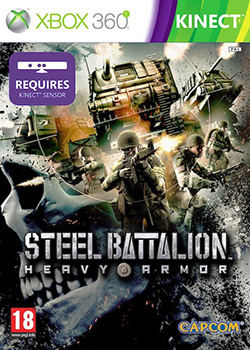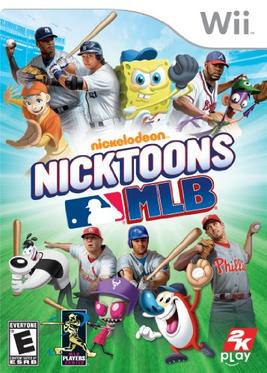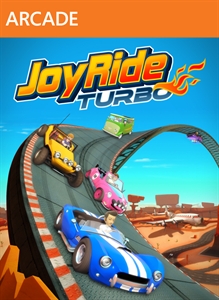
Too Human is an action role-playing game developed by Silicon Knights and published by Microsoft Studios. It was released in August 2008 for the Xbox 360. The game's story is a science-fictional futuristic retelling of Norse mythology that portrays the Æsir, the Norse gods, as cybernetically enhanced humans, tasked with protecting mankind from the onslaught of Loki's army of machines. The player takes the role of the Norse god Baldur, who is less cybernetic than the other gods thus being "too human".

Kinect is a line of motion sensing input devices produced by Microsoft and first released in 2010. The devices generally contain RGB cameras, and infrared projectors and detectors that map depth through either structured light or time of flight calculations, which can in turn be used to perform real-time gesture recognition and body skeletal detection, among other capabilities. They also contain microphones that can be used for speech recognition and voice control.

Kinect Sports is a sports video game developed by Rare and published by Microsoft Game Studios for the Xbox 360. The game utilizes the Kinect motion-sensing peripheral and was released in North America on 4 November 2010 as a launch title for Kinect, then, a few days later, in Europe and Australia.

Kinect Adventures! is a sports video game released by Microsoft Game Studios for the Xbox 360. Released in 2010, it is a collection of five adventure and sports minigames and was developed by Good Science Studio, a subsidiary of Microsoft Game Studios. The game utilizes the Kinect motion camera and was offered as a pack-in game with the console. It was unveiled at the 2010 Electronic Entertainment Expo and went on to become the best-selling game on the Xbox 360, selling 24 million units worldwide.

PrimeSense was an Israeli 3D sensing company based in Tel Aviv. PrimeSense had offices in Israel, North America, Japan, Singapore, Korea, China and Taiwan. PrimeSense was bought by Apple Inc. for $360 million on November 24, 2013.

Steel Battalion: Heavy Armor is a 2012 action game developed by FromSoftware and published by Capcom for the Xbox 360. It is a sequel to both Steel Battalion and Steel Battalion: Line of Contact on the Xbox. Steel Battalion: Heavy Armor requires the Kinect sensor and uses a combination of a Xbox 360 controller and the Kinect for gameplay. The game was widely panned by critics, mainly due to the Kinect's inability to properly read player movements and has been referred to as one of the worst video games of all time.

The Gunstringer is a third-person rail shooter video game developed by Twisted Pixel Games and published by Microsoft Studios for Xbox 360 with Kinect. It was originally planned as an Xbox Live Arcade release, but was later made into a full retail game.

Kinect Star Wars is a Star Wars video game developed by Terminal Reality and published by LucasArts and Microsoft Studios for the Xbox 360 that uses the Kinect motion peripheral. The game features four game modes: "Jedi Destiny", the primary game mode; podracing; Rancor Rampage; and Galactic Dance-off. In Jedi Destiny, players assume the role models of Jedi Padawans as they wield their lightsabers and use the Force to attack enemies mostly from the prequel trilogy using gestures. Podracing is a race-based game mode, Rancor Rampage is a destruction-based game mode, and Galactic Dance-off is a dance-based game mode similar to the Dance Central series.

Kinect Sports: Season Two is a sequel to Kinect Sports co-developed by Rare and BigPark, and published by Microsoft Studios. It was unveiled at E3 2011's Microsoft Conference for Kinect and released in October 2011. The game adds six new sports and voice control. As with the previous game, it requires the Kinect sensor. Along with its predecessor Kinect Sports, it has been released in the Kinect Sports Ultimate Collection bundle on 18 September 2012 with additional bonus content and extra sports in Season Two added, basketball, golf and skiing.

Kinect: Disneyland Adventures is a 2011 open world video game developed by Frontier Developments and published by Microsoft Studios on Kinect for Xbox 360, with a remaster for Xbox One and Microsoft Windows developed by Asobo Studio released in 2017 as simply Disneyland Adventures. It takes place in a recreation of Disneyland Park in Anaheim, California, circa 2011, with themed games in place of many of the rides, while motion controls are used to play the game.

Blackwater is a first-person shooter video game developed by Zombie Studios with the player assuming the role of a Blackwater Worldwide contractor. The game was first revealed at E3 in 2011, and was later released that year on the Xbox 360, published by 505 Games. Using the Kinect accessory for the console, the game is the first Kinect shooter on the market.

Nicktoons MLB is a baseball video game released for the Xbox 360, Wii, Nintendo DS, and Nintendo 3DS platforms. The game was developed by High Voltage Software and published by 2K in 2011. It features playable characters from Nickelodeon shows including SpongeBob SquarePants, Invader Zim, The Ren & Stimpy Show, Danny Phantom, Planet Sheen, Avatar: The Last Airbender, Fanboy & Chum Chum, T.U.F.F. Puppy, and two characters that only appear in the 3DS version, one which is from The Adventures of Jimmy Neutron, Boy Genius, and the other from the Nickelodeon game Monkey Quest. Characters from Rugrats, Rocko's Modern Life, Aaahh!!! Real Monsters, Hey Arnold!, The Angry Beavers, CatDog, El Tigre: The Adventures of Manny Rivera, Back at the Barnyard, and The Mighty B! make cameo appearances in the game's loading screens. In addition to Nickelodeon characters, the game also features players from real Major League Baseball teams.

Crimson Dragon is a rail shooter primarily developed by Grounding Inc. and published by Microsoft Studios as an Xbox One launch title. The game was published in 2013 in the West, with a Japanese release the following year. Set on the planet Draco, the story follows a dragon-riding soldier hunting the source of a disease that threatens Draco's human colony. The gameplay features the player moving an aiming reticle and shooting enemies while the dragon flies through 3D environments either on a fixed track or freely within arena-like zones. The dragon can be moved using either a standard gamepad or the console's Kinect peripheral.

Marvel Avengers: Battle for Earth is a video game developed by Ubisoft Quebec and published by Ubisoft for the Xbox 360 and the Wii U. The game is heavily based on the "Secret Invasion" storyline in Marvel comic books. The game was announced after the cancellation of the original The Avengers game based on the 2012 film of the same name, being developed by THQ. Battle for Earth was released in North America on October 30, 2012 for the Xbox 360, followed by the Wii U version on December 4. It was the first and currently only Marvel video game to be published by Ubisoft.

Joy Ride Turbo is a kart racing game for the Xbox 360 and Xbox One .The player controls their avatar as they drive vehicles in a combat racing tournament. The game was developed by BigPark and published by Microsoft Studios. It is a sequel to Kinect Joy Ride. Originally outed via a rating on the Australian Classification Board on April 11, 2012, it was unveiled by Microsoft Studios on April 27, 2012. Unlike its predecessor, Joy Ride Turbo does not use Kinect. It was released on May 23, 2012, and later added as one of the first 100 titles on the Xbox One backwards compatibility list on November 9, 2015.

Kinect Rush: A Disney–Pixar Adventure, later remastered as Rush: A Disney–Pixar Adventure, is a 2012 platform video game based on Pixar films, released for Kinect on Xbox 360. Announced on March 8, 2012 and released later that month, the game is similar to Kinect: Disneyland Adventures, but players instead are taken through the worlds of eight of Pixar's movies: Up, Toy Story, Toy Story 2, Toy Story 3, The Incredibles, Cars, Cars 2, and Ratatouille with the game hub set in a local park.

Xbox is a video gaming brand created and owned by Microsoft. The brand consists of five video game consoles, as well as applications (games), streaming service Xbox Cloud Gaming, online services such as the Xbox network and Xbox Game Pass, and the development arm Xbox Game Studios. The brand was first introduced in the United States in November 2001, with the launch of the original Xbox console. Xbox was formerly also, from 2012 to 2015, used as Microsoft's digital media entertainment brand replacing Zune.

The Xbox One is a home video game console developed by Microsoft. Announced in May 2013, it is the successor to Xbox 360 and the third console in the Xbox series. It was first released in North America, parts of Europe, Australia, and South America in November 2013 and in Japan, China, and other European countries in September 2014. It is the first Xbox game console to be released in China, specifically in the Shanghai Free-Trade Zone. Microsoft marketed the device as an "all-in-one entertainment system", hence the name "Xbox One". An eighth-generation console, it mainly competed against Sony's PlayStation 4 and Nintendo's Wii U and later the Switch.

Dance Central Spotlight is a music rhythm game developed by Harmonix and published by Microsoft Studios for the Xbox One Kinect. The game provides a stripped-down experience in comparison to previous Dance Central titles, maintaining the core gameplay of the franchise, but with a focus on providing more routines per-song, the regular release of new, recent songs as downloadable content, and leverage of improvements to the motion detection capabilities of Kinect for Xbox One.

Motocross Madness is a motocross racing video game that was developed by Austrian studio Bongfish and published by Microsoft Studios. It was released on April 10, 2013 on Xbox Live Arcade. It is a sequel to two Microsoft Windows games, 1998's Motocross Madness and 2000's Motocross Madness 2, which were developed by Rainbow Studios, who have since moved on to making the MX vs. ATV series.




















